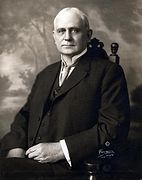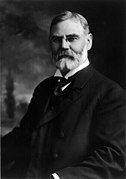United States House of Representatives elections, 1910
This article includes a list of references, but its sources remain unclear because it has insufficient inline citations. (December 2013) (Learn how and when to remove this template message) |
| ||||||||||||||||||||||||||||||||||||||||||||||||||
All 394 seats in the U.S. House of Representatives[b] 198 seats needed for a majority | ||||||||||||||||||||||||||||||||||||||||||||||||||
|---|---|---|---|---|---|---|---|---|---|---|---|---|---|---|---|---|---|---|---|---|---|---|---|---|---|---|---|---|---|---|---|---|---|---|---|---|---|---|---|---|---|---|---|---|---|---|---|---|---|---|
| ||||||||||||||||||||||||||||||||||||||||||||||||||
| ||||||||||||||||||||||||||||||||||||||||||||||||||
Elections to the United States House of Representatives in 1910 were held for members of the 62nd Congress, in the middle of President William Howard Taft's term.
The conservative Taft contended with major factional splits within his Republican Party. Instead of using his position as president to bridge compromise, Taft alienated the progressive wing of the party, which had championed his predecessor, Theodore Roosevelt. While conservatives controlled the largest number of elected positions for Republicans, progressive politics had been what brought many voters to the polls. The clash of these units of the Republican Party, combined with the message of unity from the Democratic Party, was enough to allow the Democrats to take control of the House, ending 16 years in opposition. Also, the first-ever Socialist won a seat during the elections.
Contents
1 Election summaries
2 Election dates
3 Arizona
4 California
5 Florida
6 New Mexico
7 South Carolina
8 See also
9 Notes
10 References
11 Bibliography
12 External links
Election summaries
230 | 1 | 1 | 162 |
Democratic | S | PR | Republican |
Three seats were added for the new states of New Mexico (2), and Arizona (1).
| State | Type | Total seats | Democratic | Republican | Socialist | |||
|---|---|---|---|---|---|---|---|---|
| Seats | Change | Seats | Change | Seats | Change | |||
Alabama | Districts | 9 | 9 | 0 | 0 | |||
Arizona[e] | At-large | 1 | 1 | 0 | 0 | |||
Arkansas | Districts | 7 | 7 | 0 | 0 | |||
California | Districts | 8 | 1 | 7 | 0 | |||
Colorado | Districts + at-large | 3 | 3 | 0 | 0 | |||
Connecticut | Districts + at-large | 5 | 1 | 4 | 0 | |||
Delaware | At-large | 1 | 0 | 1 | 0 | |||
Florida | Districts | 3 | 3 | 0 | 0 | |||
Georgia | Districts | 11 | 11 | 0 | 0 | |||
Idaho | At-large | 1 | 0 | 1 | 0 | |||
Illinois | Districts | 25 | 11 | 14 | 0 | |||
Indiana | Districts | 13 | 12 | 1 | 0 | |||
Iowa | Districts | 11 | 1 | 10 | 0 | |||
Kansas | Districts | 8 | 0 | 8 | 0 | |||
Kentucky | Districts | 11 | 9 | 2 | 0 | |||
Louisiana | Districts | 7 | 7 | 0 | 0 | |||
Maine[f] | Districts | 4 | 2 | 2 | 0 | |||
Maryland | Districts | 6 | 5 | 1 | 0 | |||
Massachusetts | Districts | 14 | 4 | 10 | 0 | |||
Michigan | Districts | 12 | 2 | 10 | 0 | |||
Minnesota | Districts | 9 | 1 | 8 | 0 | |||
Mississippi | Districts | 8 | 8 | 0 | 0 | |||
Missouri | Districts | 16 | 14 | 2 | 0 | |||
Montana | At-large | 1 | 0 | 1 | 0 | |||
Nebraska | Districts | 6 | 3 | 3 | 0 | |||
Nevada | At-large | 1 | 0 | 1 | 0 | |||
New Hampshire | Districts | 2 | 0 | 2 | 0 | |||
New Jersey | Districts | 10 | 7 | 3 | 0 | |||
New Mexico[e] | At-large | 2 | 1 | 1 | 0 | |||
New York | Districts | 37 | 22 | 15[d] | 0 | |||
North Carolina | Districts | 10 | 10 | 0 | 0 | |||
North Dakota | Districts | 2 | 0 | 2 | 0 | |||
Ohio | Districts | 21 | 16 | 5 | 0 | |||
Oklahoma | Districts | 5 | 3 | 2 | 0 | |||
Oregon | Districts | 2 | 0 | 2 | 0 | |||
Pennsylvania | Districts | 32 | 9 | 23 | 0 | |||
Rhode Island | Districts | 2 | 1 | 1 | 0 | |||
South Carolina | Districts | 7 | 7 | 0 | 0 | |||
South Dakota | At-large | 2 | 0 | 2 | 0 | |||
Tennessee | Districts | 10 | 8 | 2 | 0 | |||
Texas | Districts | 16 | 16 | 0 | 0 | |||
Utah | At-large | 1 | 0 | 1 | 0 | |||
Vermont[f] | Districts | 2 | 0 | 2 | 0 | |||
Virginia | Districts | 10 | 9 | 1 | 0 | |||
Washington | Districts | 3 | 0 | 3 | 0 | |||
West Virginia | Districts | 5 | 4 | 1 | 0 | |||
Wisconsin | Districts | 11 | 2 | 8 | 1 | |||
Wyoming | At-large | 1 | 0 | 1 | 0 | |||
| Total[b] | 394 | 230[d] 58.4% | 163[d] 41.4% | 1 0.3% | ||||

| 
| |||||||||||||||||||||||
Election dates
In 1910, two states, with 6 seats between them, held elections early:
- September 6 Vermont
- September 12 Maine
Two newly admitted states held elections late: New Mexico held its first Congressional election on November 7, 1911 and, Arizona held its on December 11, 1911.
Arizona
| District | Incumbent | Party | First elected | Result | Candidates |
|---|---|---|---|---|---|
Arizona at-large | None (New state) | New state. New member elected. Democratic gain. | √ Carl Hayden (Democratic) 54.1% John S. Williams (Republican) 39.7% John Halberg (Socialist) 5.9% Eugene W. Chafin (Prohibition) 0.4% | ||
California
| District | Incumbent | Party | First elected | Result | Candidates |
|---|---|---|---|---|---|
California 1 | William F. Englebright | Republican | 1906 | Incumbent lost re-election. New member elected. Democratic gain. | √ John E. Raker (Democratic) 45.4% William F. Englebright (Republican) 45.1% William Morgan (Socialist) 8.8% C. H. Essex (Prohibition) 0.7% |
California 2 | Duncan E. McKinlay | Republican | 1904 | Incumbent lost renomination. New member elected. Republican hold. | √ William Kent (Republican) 50.1% I. G. Zumwalt (Democratic) 44% W. H. Ferber (Socialist) 5.2% Henry P. Stipp (Prohibition) 0.7% |
California 3 | Joseph R. Knowland | Republican | 1904 | Incumbent re-elected. | √ Joseph R. Knowland (Republican) 81.9% S. Miller (Socialist) 15.9% James N. Christian (Prohibition) 2.2% |
California 4 | Julius Kahn | Republican | 1898 | Incumbent re-elected. | √ Julius Kahn (Republican) 56.5% Walter MacArthur (Democratic) 36.8% Austin Lewis (Socialist) 6.5% E. F. Dinsmore (Prohibition) 0.2% |
California 5 | Everis A. Hayes | Republican | 1904 | Incumbent re-elected. | √ Everis A. Hayes (Republican) 59.4% Thomas E. Hayden (Democratic) 27.4% E. L. Reguin (Socialist) 12.6% T. E. Caton (Proh.) 0.6% |
California 6 | James C. Needham | Republican | 1898 | Incumbent re-elected. | √ James C. Needham (Republican) 47.3% A. L. Cowell (Democratic) 44.2% Richard Kirk (Socialist) 6.2% Ira E. Surface (Proh.) 2.3% |
California 7 | James McLachlan | Republican | 1900 | Incumbent lost renomination. New member elected. Republican hold. | √ William Stephens (Republican) 58.7% Lorin A. Handley (Democratic) 21.5% Thomas W. Williams (Socialist) 16.6% C. V. LeFontaine (Proh.) 3.2% |
California 8 | Sylvester C. Smith | Republican | 1904 | Incumbent re-elected. | √ Sylvester C. Smith (Republican) 50.5% William G. Irving (Democratic) 33.9% George A. Garrett (Socialist) 13.1% James S. Edwards (Proh.) 2.5% |
Florida
| District | Incumbent | Party | First elected | Result | Candidates |
|---|---|---|---|---|---|
Florida 1 | Stephen M. Sparkman | Democratic | 1894 | Incumbent re-elected. | √ Stephen M. Sparkman (Democratic) 81.8% C. C. Allen (Socialist) 18.2% |
Florida 2 | Frank Clark | Democratic | 1904 | Incumbent re-elected. | √ Frank Clark (Democratic) 78.5% Thomas W. Cox (Socialist) 12.2% Thomas C. Buddington (Republican) 9.3% |
Florida 3 | Dannite H. Mays | Democratic | 1908 | Incumbent re-elected. | √ Dannite H. Mays (Democratic) 89.6% Eric Vonaxelson (Democratic) 10.4% |
New Mexico
| District | Incumbent | Party | First elected | Result | Candidates |
|---|---|---|---|---|---|
New Mexico at-large | None (New state) | New state. New member elected. Republican gain. | √ George Curry (Republican) 25.0% √ Harvey B. Fergusson (Democratic) 24.9% Elfego Baca (Republican) 23.7% Paz Valverde (Democratic) 23.5% J. W. Hansen (Socialist) 1.5% C. Cutting (Socialist) 1.4% | ||
| New state. New member elected. Democratic gain. | |||||
South Carolina
| District | Incumbent | Party | First elected | Result | Candidates |
|---|---|---|---|---|---|
South Carolina 1 | George Swinton Legaré | Democratic | 1902 | Incumbent re-elected. | √ George Swinton Legaré (Democratic) 97.4% Aaron P. Prioleau (Republican) 2.1% William Eberhard (Socialist) 0.5% |
South Carolina 2 | James O'H. Patterson | Democratic | 1904 | Incumbent lost renomination. New member elected. Democratic hold | √ James F. Byrnes (Democratic) 100% |
South Carolina 3 | Wyatt Aiken | Democratic | 1902 | Incumbent re-elected. | √ Wyatt Aiken (Democratic) 99.9% Others 0.1% |
South Carolina 4 | Joseph T. Johnson | Democratic | 1900 | Incumbent re-elected. | √ Joseph T. Johnson (Democratic) 98.9% Thomas Brier (Republican) 1.1% |
South Carolina 5 | David E. Finley | Democratic | 1898 | Incumbent re-elected. | √ David E. Finley (Democratic) 100% |
South Carolina 6 | J. Edwin Ellerbe | Democratic | 1904 | Incumbent re-elected. | √ J. Edwin Ellerbe (Democratic) 100% |
South Carolina 7 | Asbury F. Lever | Democratic | 1901 (special) | Incumbent re-elected. | √ Asbury F. Lever (Democratic) 95.6% R. H. Richardson (Republican) 4.3% Others 0.1% |
See also
United States elections, 1910
- United States Senate elections, 1910
- 61st United States Congress
- 62nd United States Congress
Notes
^ Maine and Vermont held elections early, in September 1910. Two newly admitted states, New Mexico and Arizona, held their elections late, in November and December 1911, respectively.
^ ab Including late elections
^ Including one Independent Republican.
^ abcd Including one Progressive Republican member, Theron Akin, of NY-25.
^ ab New state
^ ab Elections held early.
References
^ abc "Party Divisions of the House of Representatives* 1789–Present". Office of the Historian, United States House of Representatives. Retrieved May 18, 2015..mw-parser-output cite.citation{font-style:inherit}.mw-parser-output q{quotes:"""""""'""'"}.mw-parser-output code.cs1-code{color:inherit;background:inherit;border:inherit;padding:inherit}.mw-parser-output .cs1-lock-free a{background:url("//upload.wikimedia.org/wikipedia/commons/thumb/6/65/Lock-green.svg/9px-Lock-green.svg.png")no-repeat;background-position:right .1em center}.mw-parser-output .cs1-lock-limited a,.mw-parser-output .cs1-lock-registration a{background:url("//upload.wikimedia.org/wikipedia/commons/thumb/d/d6/Lock-gray-alt-2.svg/9px-Lock-gray-alt-2.svg.png")no-repeat;background-position:right .1em center}.mw-parser-output .cs1-lock-subscription a{background:url("//upload.wikimedia.org/wikipedia/commons/thumb/a/aa/Lock-red-alt-2.svg/9px-Lock-red-alt-2.svg.png")no-repeat;background-position:right .1em center}.mw-parser-output .cs1-subscription,.mw-parser-output .cs1-registration{color:#555}.mw-parser-output .cs1-subscription span,.mw-parser-output .cs1-registration span{border-bottom:1px dotted;cursor:help}.mw-parser-output .cs1-hidden-error{display:none;font-size:100%}.mw-parser-output .cs1-visible-error{font-size:100%}.mw-parser-output .cs1-subscription,.mw-parser-output .cs1-registration,.mw-parser-output .cs1-format{font-size:95%}.mw-parser-output .cs1-kern-left,.mw-parser-output .cs1-kern-wl-left{padding-left:0.2em}.mw-parser-output .cs1-kern-right,.mw-parser-output .cs1-kern-wl-right{padding-right:0.2em}
^ abc Martis, pp. 164–165.
Bibliography
Dubin, Michael J. (March 1, 1998). United States Congressional Elections, 1788-1997: The Official Results of the Elections of the 1st Through 105th Congresses. McFarland and Company. ISBN 978-0786402830.
Martis, Kenneth C. (January 1, 1989). The Historical Atlas of Political Parties in the United States Congress, 1789-1989. Macmillan Publishing Company. ISBN 978-0029201701.
Moore, John L., ed. (1994). Congressional Quarterly's Guide to U.S. Elections (Third ed.). Congressional Quarterly Inc. ISBN 978-0871879967.
"Party Divisions of the House of Representatives* 1789–Present". Office of the Historian, House of United States House of Representatives. Retrieved January 21, 2015.
External links
Office of the Historian (Office of Art & Archives, Office of the Clerk, U.S. House of Representatives)

